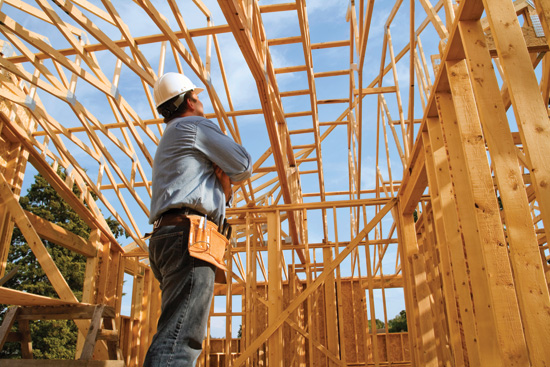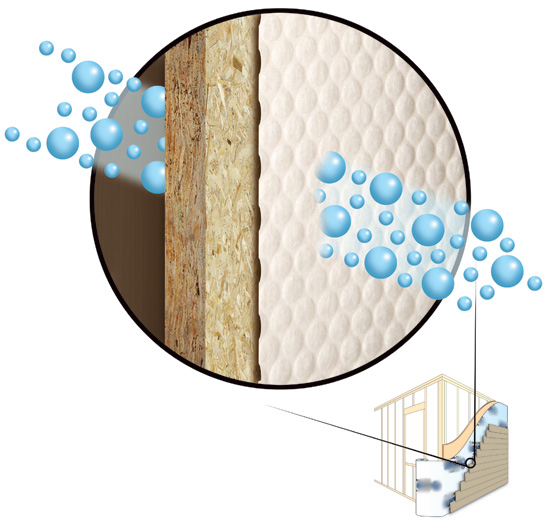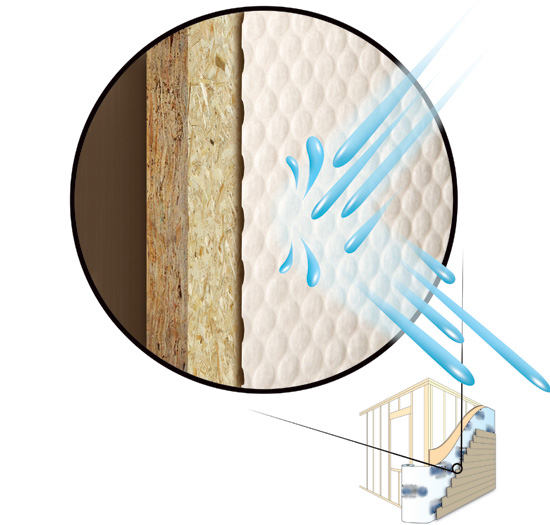Effective and Affordable House Wraps
Types of House Wraps
There are several types of WRB—asphalt felt, Grade D building paper, plastic house wrap, and liquid-applied WRB, among others. Tar paper, or felt as it is now referred to, was the preferred choice of WRB many years ago. Felt has evolved from a heavy, unwieldy material to a lighter, water-resistant material. While some builders prefer it, felt is still relatively heavy, and is susceptible to punctures, and the fact that it traditionally comes in 3-foot-wide rolls makes it somewhat cumbersome and time consuming to install. Advocates note that if wet, felt is absorbent and will gradually dry. Most often used in the western U.S. and under stucco, grade D paper is a lighter-weight, lower-cost asphalt-saturated paper. Grade D paper has a minimum water-resistance rating of 10 minutes, with many manufacturers far exceeding the minimum requirements. Still, if Grade D paper becomes and stays wet, rot may occur. Liquid-applied WRBs are another option. Sprayed or rolled on sheathing, they form a coating that is air tight and resistant to water penetration. One drawback with liquid-applied materials is their high cost relative to other alternatives. A consistent thickness must be achieved, adequate attention paid to detailing, the proper cure time observed, and protective clothing worn during the application process. Air and water resistant, liquid-applied materials vary as to vapor permeability effectiveness.

Photo courtesy of Kimberly-Clark
Installing a WRB between the sheathing and the cladding is a second line of defense in moisture protection.
Modern House Wraps
In use for more than four decades, plastic house wraps provided an alternative to asphalt-saturated felt. Because WRBs come in rolls that are wider than asphalt—9 to 10 feet being the industry standard—they can be installed more quickly and easily. Fabricated from woven or non-woven polyethylene or polypropylene in various processes, a plethora of modern house wraps are available with a range of water resistance, water permeability, performance and durability characteristics. House wraps can be woven or non-woven, which are typically sheets bonded together chemically, thermally, or mechanically. They can be further categorized as perforated or non-perforated. While some house wraps are manufactured for natural permeability, others rely on small holes to provide permeability. In other words, to achieve water vapor transfer some house wraps have micro-perforations while others are micro-porous, having the technology to allow water vapor to diffuse through the fibers of the fabric itself, helping to remove trapped moisture within the structure.
Unlike non-wovens, most woven products typically achieve vapor permeability though the use of micro-perforations. While micro-perforations do add to a material's breathability, they tend to compromise its resistance to liquid water penetration and air flow, presenting the possibility of water damage and negative implications for the integrity of the insulation and associated energy costs.
Next-Generation House Wraps
In contrast to traditional house wraps that only provided a water-resistive layer that could trap water in the wall cavity, the emphasis today is on drainable house wraps which provide a drainage gap that allows water to exit the wall cavity as quickly as possible, resulting in a dramatically better removal of water from a wall system.
Next-generation house wraps do not sacrifice breathability for liquid water resistance, or vice versa, with manufacturers claiming these materials can prevent water penetration while providing a breathable barrier technology that allows moisture vapor from inside the home to escape, maintaining a dry building structure for long periods of time. Breathability in a house wrap is critical particularly when considered in light of the fact that, in an average household, occupant activities from breathing to bathing to cooking emit up to 6 gallons of moisture a week—that water has to go somewhere. If the house wrap does not breathe properly, the moisture will escape through the walls, and enter the wall cavity where it is stopped and trapped if the house wrap is non-breathable, the result of course being the potential for degradation of many commercial insulation products as well as for rot, mold, and eventually, structural failure.

The vapor-permeable membrane allows moisture in the building to escape, protecting the structure from rot and mold.

As an air barrier, a house wrap helps to reduce heating and cooling cost.

Images courtesy of Kimberly-Clark
House wraps act as a barrier, keeping wind-driven rain and other water from reaching the sheathing.









